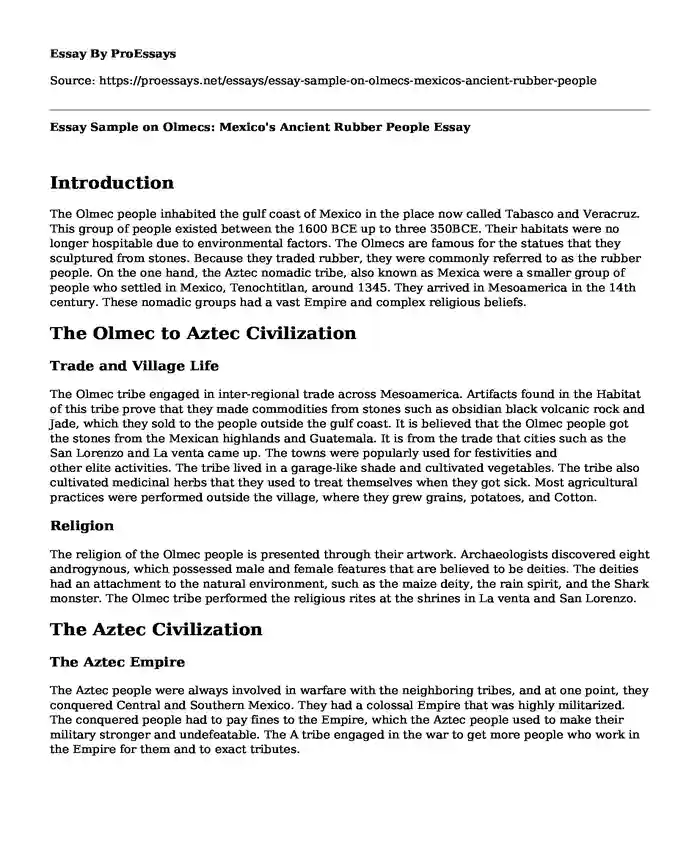Introduction
The Olmec people inhabited the gulf coast of Mexico in the place now called Tabasco and Veracruz. This group of people existed between the 1600 BCE up to three 350BCE. Their habitats were no longer hospitable due to environmental factors. The Olmecs are famous for the statues that they sculptured from stones. Because they traded rubber, they were commonly referred to as the rubber people. On the one hand, the Aztec nomadic tribe, also known as Mexica were a smaller group of people who settled in Mexico, Tenochtitlan, around 1345. They arrived in Mesoamerica in the 14th century. These nomadic groups had a vast Empire and complex religious beliefs.
The Olmec to Aztec Civilization
Trade and Village Life
The Olmec tribe engaged in inter-regional trade across Mesoamerica. Artifacts found in the Habitat of this tribe prove that they made commodities from stones such as obsidian black volcanic rock and Jade, which they sold to the people outside the gulf coast. It is believed that the Olmec people got the stones from the Mexican highlands and Guatemala. It is from the trade that cities such as the San Lorenzo and La venta came up. The towns were popularly used for festivities and other elite activities. The tribe lived in a garage-like shade and cultivated vegetables. The tribe also cultivated medicinal herbs that they used to treat themselves when they got sick. Most agricultural practices were performed outside the village, where they grew grains, potatoes, and Cotton.
Religion
The religion of the Olmec people is presented through their artwork. Archaeologists discovered eight androgynous, which possessed male and female features that are believed to be deities. The deities had an attachment to the natural environment, such as the maize deity, the rain spirit, and the Shark monster. The Olmec tribe performed the religious rites at the shrines in La venta and San Lorenzo.
The Aztec Civilization
The Aztec Empire
The Aztec people were always involved in warfare with the neighboring tribes, and at one point, they conquered Central and Southern Mexico. They had a colossal Empire that was highly militarized. The conquered people had to pay fines to the Empire, which the Aztec people used to make their military stronger and undefeatable. The A tribe engaged in the war to get more people who work in the Empire for them and to exact tributes.
Religion
The Aztec religion had complex religious beliefs. They had so many gods that they worshipped through a ritual calendar found in the British Museum. The Aztec people's ritual calendar used the agricultural seasons. They made sculptures that presented their religion due to the visual impact that the statues had. The Aztec tribe worships their gods through music. They had musical instruments such as drums that they used as accompaniments. The ritual sculptures that the Aztec people made were highly decorated. As a ritual, the Aztec Empire raided tribes where they brought people that they gave as human sacrifices to appease their gods.
Trade and infrastructure
The Aztec people made roads that they traveled on foot as they did not have any locomotives. The roads facilitated the Aztec people's accessibility to the outside world, where they traded with other tribes. The roads also acted as channels of communication, which provided contact between the Aztec people and the outside world. These people sold in jewelry that they manufactured from raw materials that they imported from outside the Empire. They also made garments which they traded internally and externally. The tribe also did pottery, rubber, and Jade.
Inca and Chavin Civilization
The Chavin tribe habited the Andean region of South America. The Chavin tribe gets its name from the Chavin de Huantar temple, where they had established their territory. The Inca inhabited the coastal deserts of Peru Around 3200 BCE. These people various domesticated animals and cultivated land. They planted maize, which they used domestically and traded with the neighboring tribes. They also planted wheat and barley and used irrigation because the place was dry. Also, the Inca people domesticated guinea pigs and llamas.
Agriculture
The territory was conveniently located between two rivers, which provided water for the people. They planted maize that did very well in the valleys. In the uplands, they planted potatoes due to high altitudes of the Andes Mountains. They practiced specialist production. Apart from producing maize and vegetables, they also grew quinoa. The Chavin people used irrigation systems during dry Seasons. They preserved crops and animal products by drying them.
Art and Religion
The Chavin people had unique art. They used dramatic expressions in making sculptures. For instance, the deity at the Temple is the most common, which is called Lanzon. The god was 4.5 meters and was made of granite. The Lanzon linked the Chavin people to the heavens and the underworld. At the Temple, there was also another gigantic sculpture which was made of granite called Tello Obelisk. The sculpture had inscriptions of animals, plants, and people, which is believed to be a connection between the heavens, the Earth, and the underworld.
Conclusion
Work Cited
Spinden, Herbert J. Ancient Civilizations of Mexico and Central America. Courier Corporation, 2011.
Cite this page
Essay Sample on Olmecs: Mexico's Ancient Rubber People. (2023, Sep 25). Retrieved from https://proessays.net/essays/essay-sample-on-olmecs-mexicos-ancient-rubber-people
If you are the original author of this essay and no longer wish to have it published on the ProEssays website, please click below to request its removal:
- Managed Health Care in America Essay
- Gilded Age and Progressive Era Essay
- Direct Democracy in California Essay
- Essay Example on Asia and America: Top Economies & Markets for Business Investments
- Paper Example on Comparing Art Design Culture in China and Malaysia
- Essay on Reforming the American Juvenile System: Economic, Social, and Racial Discrepancies
- Essay Example on US Internment of Japanese Americans: Fred Korematsu's Story







